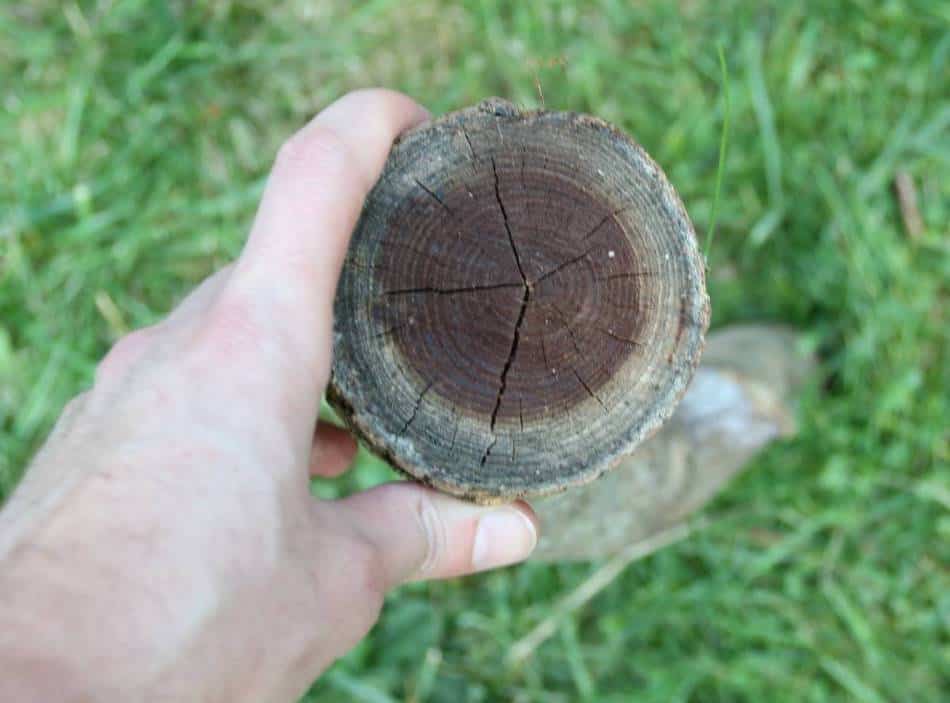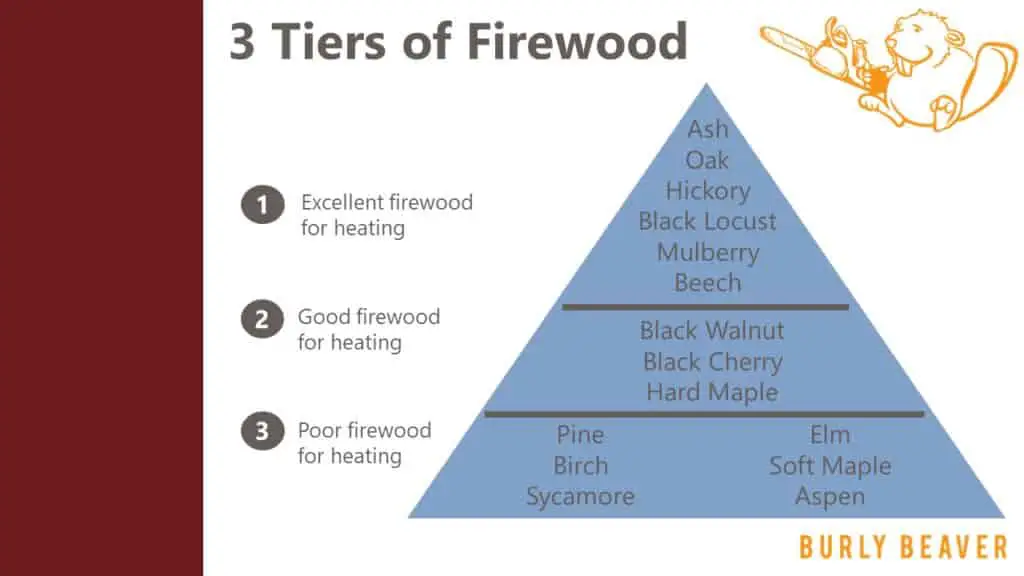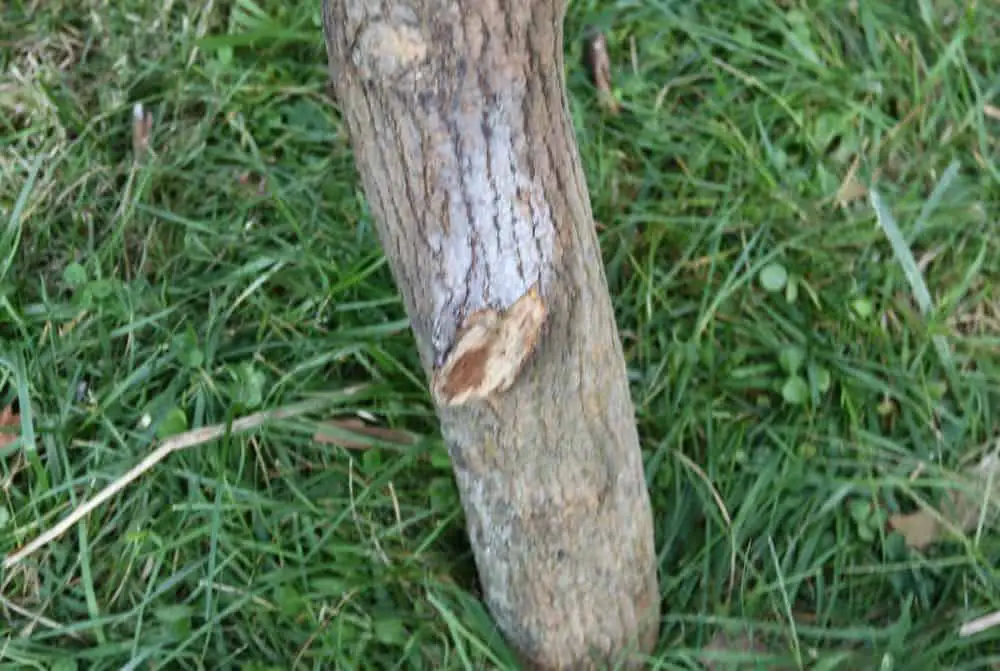
My wife loves Mulberry trees. She’s mostly interested in the berries, but gets excited whenever she sees one.
If you have a dead Mulberry tree, or there’s just a lot of them in your area, you may be wondering if it also makes good firewood. Let’s start with a quick answer to the main question:
Is Mulberry good firewood?
Mulberry is excellent firewood. It has a high heat output of 25.8 million BTUs per cord of seasoned wood. In addition, Mulberry smells nice and produces great coals. The biggest issue with Mulberry firewood is that it produces heavy sparks. So it’s not a good choice for indoor open-air fireplaces.
That’s the quick answer, but there’s more to it than that. Below we’ll cover the characteristics you can use to compare Mulberry to different types of common firewood. Let’s get to it!
Mulberry vs. Other Firewood

To give you a quick view of how Mulberry compares to other types of firewood, we’ve put together a graphic below, which provides a snapshot of some of the most common types of firewood in our area (in the Midwest USA), and they are divided into 3 levels of quality.
Within each tier, the types of firewood are not ranked but are considered close in performance. Also, the tiers are actually based primarily on data from several university extension offices.
To learn more about the data sources, you can read the note below the image. Now, here it is!

The information in this image is based largely off of data from the following sources: Utah State University Forestry Extension, Oklahoma Cooperative Extension Service, University of Illinois Extension, University of Missouri Extension, South Dakota State University Extension. In addition, where there was missing data (only a few occasions), I’ve used my own experience to round out the data.
In addition to heat output, these levels of quality take additional factors into consideration, including smoke output, quality of coals, and fragrance.
In the next section, we’ll dig into the 6 most important burn qualities, why they’re important, and how Mulberry performs in each category.
The 6 Burn Qualities of Mulberry

1. Heat Output vs Other Firewood
Mulberry has great heat output, and it actually burns hotter than Ash, which is one of the most popular types of firewood.
Everyone has their own opinion on which type of firewood produces the most heat, but to get a clearer picture, let’s use a data-driven approach.
Check-out the table below to see a comparison of BTU data for 15 common firewood species’. Mulberry is marked with bold text. (Note: data sources are mentioned beneath the infographic above).
Heat Output of Common Firewood
| Species | BTUs | Weight/Cord (lbs) |
| Black Locust | 29.3 | 4192 |
| Hickory | 28.5 | 4072 |
| Beech | 27.5 | 3760 |
| Oak (White) | 26.4 | 3776 |
| Mulberry | 25.8 | 3712 |
| Ash | 24.2 | 3472 |
| Maple (Hard) | 23.9 | 3408 |
| Black Walnut | 22.2 | 3192 |
| Pine (Southern Yellow) | 22 | 2936 |
| Birch | 20.8 | 2992 |
| Sycamore | 24.1 | 2872 |
| Black Cherry | 20.4 | 2928 |
| Elm | 20 | 2872 |
| Maple (Soft) | 19 | 2752 |
| Aspen | 18.2 | 2160 |
As you can see, for this list of firewood types, Mulberry is in the top 5 for heat output. It’s up there with Oak, and Ash, which is great company!
Heat output is definitely an important characteristic for firewood, but it’s not the only thing that matters. There are a few other factors, that will affect how good the wood is for heating or for outdoor campfires.
Next up, let’s look at smoke output.
2. Amount of Smoke
Mulberry is in the middle of the spectrum here. It doesn’t produce a lot of smoke, but it produces more smoke than many of the top tier firewoods like Ash and Oak.
On the other hand, Mulberry produces less smoke than a few other types of firewood, like Hard Maple and Pine.
High smoke production may also be a sign that wood is not fully dried, and you want to make sure that you’re always properly seasoning your wood before burning it. Jump down to this section to learn more about seasoning.
3. Does it Spark?
This is the biggest shortcoming of Mulberry firewood. Mulberry is known to produce a lot of sparks when it burns. This can be an issue depending on where (and how) you plan to burn the wood.
For example, if your planning to light a fire in an indoor open-air fireplace then I would avoid burning Mulberry. It’s probably not worth the fire risk, and you also want to avoid burn marks from any stray sparks.
However, if you’re using an enclosed wood stove, or if you’re using a safe outdoor fire pit, then Mulberry is still a good choice.
4. Smell or Fragrance
Some types of firewood are famous for having a nice fragrance. Cherry and Hickory are both great examples of this. Since smell is so closely associated with flavor, some fragrant woods are also used for BBQ and smoking meats.
Mulberry has a very nice smell when it’s burned, and some people really like its fragrance. However, it’s not quite on the same level as Cherry, and it didn’t make our list of the 11 best smelling firewoods.
Still a good choice though, and certainly better than Buckeye or Elm, which can have really unpleasant aromas.
5. Does it Produce Coals?
Another factor that is commonly used for rating firewood is “coaling”. When any kind of firewood burns it produces coals, and the quality of the coals produced has a big impact on how long (and how well) the fire will continue burning.
For example, wood that has great coaling properties will work well as an overnight fuel in wood stoves, because the quality coals will help the fire stay hot through the night.
These long-lasting coals can also help you to easily re-start a fire in the morning by simply adding more wood to the existing embers.
Firewood that is on the top of the list for BTU output, tend to have very good coaling properties, and Mulberry is one of them. You can expect the coals from Mulberry to be high-quality, and long-burning.
6. Creosote Build-Up
If you’re using a fireplace or wood stove in your home, another important thing to consider is the maintenance of your chimney, and specifically preventing creosote build-up.
If you’ve not heard of creosote before, it’s a side product of burning wood, and it’s basically a black tar that is gradually deposited by wood smoke on the inside walls of a chimney.
Creosote isn’t a problem in small quantities, but if it gets built up, it can be quite dangerous. Build-up of creosote can reduce the ventilation of your chimney, and it’s also HIGHLY flammable, which can cause chimney fires.
To prevent creosote build-up, it’s important to properly maintain your stove and to have your chimney cleaned regularly.
In addition, you should only ever burn wood that is thoroughly seasoned (dried), because wet wood produces more creosote. Another big factor is the type of wood you’re burning.
In general, firewood that is very sappy will produce much more creosote build-up than firewood that is not as sappy.
Most hardwood firewood, including Mulberry, have low sap levels and produce less creosote than very sappy firewood like Pine.
Speaking of Pine, it’s probably the worst type of wood when it comes to creosote build-up. Many people, including my family, completely avoid burning Pine in wood stoves as a result.
Burn Quality Overall Comparison

Alright, now that we’ve covered the 6 most important burning qualities for Mulberry, let’s boil it down to the biggest highlights.
- Mulberry has excellent heat output compared with other types of firewood in our area and even burns hotter than Ash.
- Mulberry produces great coals which are capable of burning for a long time, and producing heat throughout the night.
- Mulberry produces many sparks and should be avoided in places with significant fire risks.
Next, we’ll briefly touch on identification for Mulberry firewood.
Identifying Mulberry Firewood

Mulberry has a few distinctive characteristics that you can use to help you identify it.
First, you’ll notice the colors in the photo above. Mulberry often has a red-colored heartwood (e.g. the center of the log), and white or light-brown sapwood (e.g. the outer ring of the log).
In our area, not many types of firewood have red-colored wood. Cherry also has red colors, but it is red throughout and doesn’t have the outer white ring.
So, if you find a piece of wood with a red center and white outer ring, then there’s a really good chance it’s Mulberry.
But let me give you another thing to look for, to help you confirm the identification. Mulberry trees often get light white “streaks” on their outer bark. See the photo below:

Do you see the white colors immediately above the broken branch? This is a pretty unique feature of Mulberry trees.
In most cases, these two methods will probably work for you. But if you’re struggling, you can always fall back on leaf identification. Mulberry trees have alternate-simple leaves.
This means they grow on branches in a left-right-left pattern, and grow as individual leaves (rather than leaflets attached to a larger “compound” leaf). They are also small in size, and have jagged edges. See photo below.
If it’s the right time of year, you may also be able to spot their dark purple berries, which are quite delicious.

Now for our final topic, seasoning your Mulberry firewood.
Seasoning Mulberry Firewood
In general, firewood will take at least 6-8 months to fully season and for some types of wood, this process can take even longer. You should expect it to take a year or more to season Mulberry firewood.
For wood to be “seasoned” basically just means that it’s thoroughly dried, and you should always plan to burn firewood that is completely seasoned.

Exactly how long it will take depends on several factors, including the climate where you’re located (e.g. wood dries faster in Texas than in Oregon), and if you’ve properly split and stacked the wood.
In order to expedite the process, and to get your firewood seasoned as quickly as possible, use the following tips for fast drying:
5 Tips for Seasoning Firewood Fast
1. Split the firewood
firewood dries WAY faster when it is split into pieces, rather than sitting in log-form. Think about it, when the wood is split more surface area is exposed to the wind and sunshine, which are the primary contributors to dry wood.
2. Elevate the firewood
You may do a double take here, because a lot of people don’t do this step due to the extra effort required. And I’ll admit, this isn’t absolutely essential, but if you put your stack of firewood up on some pallets or perpendicular planks, it will increase airflow beneath the firewood stack and will accelerate your drying time.
3. Stack the firewood
To optimize your drying time, you should stack your firewood neatly in a location that will maximize the amount of sunshine and airflow. For example, stack the wood away from buildings (out of the shade), and point the face of the stack (not the ends) towards the direction from which you get the most breeze.
4. Leave space between rows
if you make multiple stacks of firewood, each stack should be separated by at least a few inches for airflow. This will allow both stacks of wood to dry better.
5. Cover (optional)
If your wood pile is outside you can put a cover or tarp over the stack to drain any rain/snow. Just make sure that it doesn’t totally block airflow from the side of the stack, otherwise it will trap in moisture and make seasoning take longer. You may also wonder if you can stack firewood in a garage or shed, you can read more about that here.
And if you want to learn more about seasoning firewood, you should also take a look at this article.
Related Questions
What is the Best Firewood?
The best type of firewood for heating a home with a wood stove, is Black Locust or Hickory, due to the high heat output and long-lasting coals. For outdoor campfires, Pine or Cedar are better because they produce a pleasant fire that doesn’t burn too long.
Is Mulberry a Tree or Bush?
Mulberry is a tree because it has a single central stem (e.g. the trunk of the tree), and it is capable of growing to a height of 20-40 feet tall. The maximum height and the single stem are both important characteristics that can be used to distinguish a tree from a bush.
